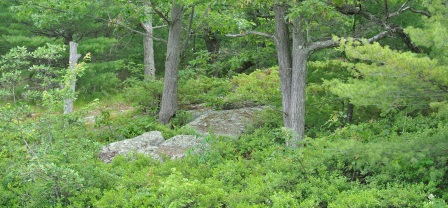Muskoka’s Biodiversity – Part 3: Managing for the conservation of biodiversity

The previous two articles in this series have talked about the importance of biodiversity and how Muskoka’s biodiversity has changed and will continue to change. What can we, as a community, do to manage these changes so that biodiversity and ecosystem function are maintained?
Both on land and in the water, the Muskoka River watershed of today is a stage in a journey as ecosystems shift and change, sometimes, but not always, because of human activity. It follows that, if maintenance of watershed health is to be our goal, we have to understand, anticipate, and (where possible) manage the changes that will surely come in the future, even if climate change and biodiversity loss were not upon us.
We face a significant challenge, but the role of biodiversity in promoting ecosystem resilience offers us a clear path forward.
To put it simply, biodiversity confers resilience, and resilient ecosystems respond better to environmental changes, continuing to function well and continuing to provide the goods and services on which we depend.
With change of many types happening, and knowing that we will not be able to control all change, the Muskoka community should adopt management approaches that conserve biodiversity throughout our region.
This “management for conservation of biodiversity” is simply good stewardship – acting in ways that favour long-term sustainability of ecosystem function. It is a task for land owners, other seasonal and permanent residents, visitors, provincial ministries, and local and regional governments. All members of our community will benefit from such stewardship; the challenge is that with climate change and growing pressures of development, the task of conserving biodiversity becomes more difficult.
For example, if our goal is to conserve the biodiversity of our forests, then the following set of principles adapted from the paper Forest Resilience, Biodiversity, and Climate Change (Thompson et al., 2009) provide a basis for preserving forest biodiversity through enhancing forest resilience:
- Maintain genetic diversity in forests by not selecting only certain trees for harvesting based on site, growth rate, or form, and replant with trees of different genotypes.
- Ensure managed forests remains as structurally complex as natural forests, using natural forests as a model.
- Maintain connectivity across forest landscapes by reducing fragmentation, recovering lost habitat types, and expanding protected area networks.
- Maintain functional diversity (and redundancy) by ensuring that forests do not get replaced with a monoculture.
- Reduce non-natural competition by controlling invasive species and using a variety of native species in reforestation projects.
- When planting trees, use local stock that is adapted to the climate while also planning for future climatic changes by planting species that will thrive in expected future conditions.
- Maintain biodiversity at all scales (stand, landscape, bioregional) and of all elements (genetic, species, community) by protecting isolated populations of organisms, populations at the limits of their distribution, and populations in areas that are naturally buffered from extreme climate change. These populations are the most likely to form core populations as conditions change.
- Encourage local governments to implement natural areas strategies that identify representative protected areas; and corridors and connections between them.
Learn more about biodiversity in Muskoka in the MWC publication Muskoka’s Biodiversity: Understanding our Past to Protect our Future, available at www.muskokawatershed.org.
Past articles are available in this blog under the Watershed Notes Articles category or under Past Articles in the Resources section.
